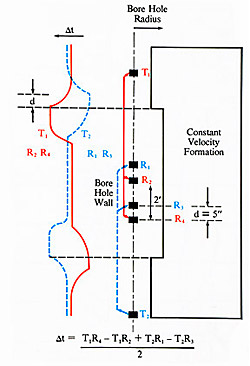Borehole Compensated Sonic Tool (BHC*)
Description
The BHC sonde measured the time required for a compressional sound wave to travel through one foot of formation. The BHC consisted of an upper and lower transmitter arranged symmetrically on either side of two pair of receivers. The spacings T1-R2 and T1-R4 were 3 and 5 feet apart, as well as the spacings T2-R3 and T2-R1. The transmitters were pulsed alternately and the transit time of the compressional wave in the formation, measured in microseconds per foot, was given by: Δt=1/2 (T1R4-T1R2+T2R1-T2R3)
The BHC was used during the Deep Sea Drilling Project from 1975-1982 and the Ocean Drilling Program from 1987-1998. It was also deployed during IODP Expedition 302.
Applications
Porosity and “pseudo density” . The sonic transit time can be used to compute porosity by using the appropriate transform, and to estimate fracture porosity in carbonatic rocks. In addition, it can be used to compute a “pseudodensity” log over sections where this log has not been recorded or the response was not satisfactory.
Seismic impedance. The product of compressional velocity and density is useful in computing synthetic seismograms for time-depth ties of seismic reflectors.
Sonic waveform analysis. If a refracted shear arrival is present, its velocity can be computed from the full waveforms, and the frequency content and energy of both compressional and shear arrivals can also be determined.
Environmental Effects
One common problem is cycle skipping: a low signal level, such as that occurring in large holes and soft formations, can cause the far detectors to trigger on the second or later arrivals, causing the recorded Δt to be too high. This problem can also be related to the presence of fractures.
Transit time stretching appears when the detection at the further detector occurs later because of a weak signal. Finally, noise peaks are caused by triggering of detectors by mechanically induced noise, which causes the Δt to be too low.
Log Presentation
Delay times (µsec/ft) were usually displayed along with gamma ray and resistivity data.
Environmental Effects
One common problem is cycle skipping: a low signal level, such as that occurring in large holes and soft formations, can cause the far detectors to trigger on the second or later arrivals, causing the recorded Δt to be too high. This problem can also be related to the presence of fractures.
Transit time stretching appears when the detection at the further detector occurs later because of a weak signal. Finally, noise peaks are caused by triggering of detectors by mechanically induced noise, which causes the Δt to be too low.
Log Presentation
Delay times (µsec/ft) were usually displayed along with gamma ray and resistivity data.
Tool Specifications
| Temperature rating: | 350° F (175° C) |
| Pressure rating: | 20 psi (138 MPa |
| Diameter: | 3.625 in (9.21 cm) |
Major Outputs
| DT: | Delay time (5 ft) (µsec/ft) |
| TT1: | Transit time 1 (5 ft) (µsec) |
| TT2: | Transit time 2 (5 ft) (µsec) |
| TT3: | Transit time 3 (5 ft) (µsec) |
| TT4: | Transit time 4 (5 ft) (µsec) |
Deployment Notes
The BHC could be run alone or in combination with resistivity and gamma ray tools.
* ®trademark of Schlumberger

